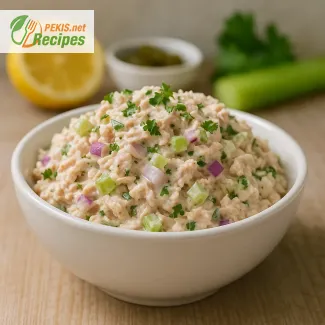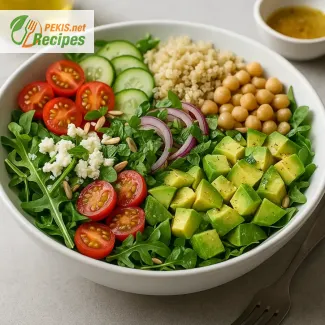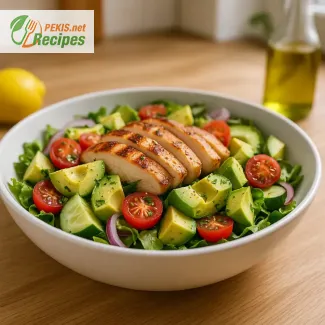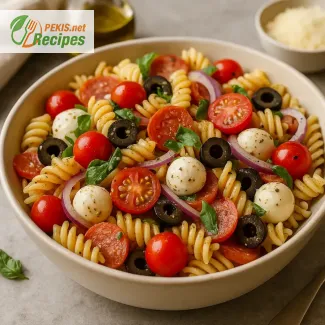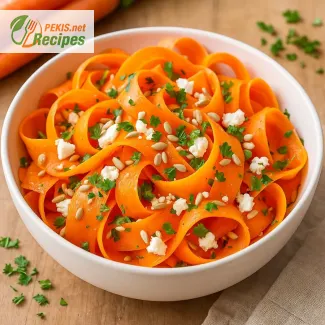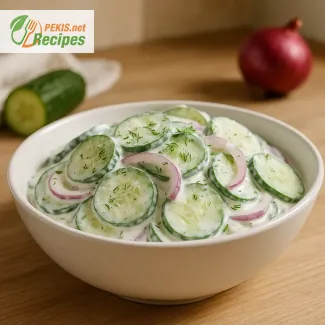
Refreshing Summer Flavors with Creamy Cucumber Salad
A cool and light dish perfect for hot weather and easy meals
When the weather gets warm, few dishes are as welcome on the table as a creamy cucumber salad. With its crisp texture and cooling taste, this salad provides the perfect balance of freshness and richness. Whether served at a barbecue, picnic, or as a quick weekday side, its simplicity and versatility make it a favorite for cooks of all skill levels. Combining crunchy cucumbers, a velvety dressing, and delicate herbs, this salad offers a harmonious bite that’s both light and satisfying.
This dish has stood the test of time, appearing in various forms across many cuisines. From traditional German Gurkensalat to classic Southern-style variations, the cucumber salad recipe has evolved but never lost its appeal. In its modern, creamy interpretation, it brings together the best of seasonal ingredients and quick preparation. It’s a side dish that works equally well with grilled meats, baked fish, or plant-based mains.
The appeal of cucumbers in seasonal cuisine
Why cucumbers are a summer essential
Cucumbers are celebrated for their high water content and subtle sweetness, making them an ideal base for warm-weather dishes. Their naturally mild flavor allows them to pair effortlessly with a wide range of dressings—from tangy vinegar-based to indulgently creamy. In this version, the creaminess enhances the cool crunch of the cucumbers, while the acidity from vinegar or lemon juice adds brightness.
Cucumber salad is also a smart choice for make-ahead meals, as it stores well and can be prepared in large batches. Whether thinly sliced, spiralized, or diced, cucumbers take on the flavor of any dressing without losing their structure. This makes them particularly suitable for creamy preparations that rest in the fridge before serving.
Ingredients that elevate simple flavors
Building a balanced and creamy dressing
A creamy cucumber salad relies on just a few pantry staples to create its signature texture and taste. Classic ingredients like sour cream, Greek yogurt, or mayonnaise form the base, depending on the desired richness. To that, add white vinegar or fresh lemon juice for acidity, a touch of sugar to balance the tang, and a pinch of salt and pepper to season.
Fresh herbs like dill, chives, or parsley bring a burst of green and a gentle aroma. For added flavor, some variations include minced garlic, onion slices, or a sprinkle of mustard seeds. These simple additions can dramatically enhance the final dish while preserving its creamy core.
The quality of the cucumbers themselves also plays a crucial role. English cucumbers are often preferred due to their thinner skin and lower seed content. However, standard garden cucumbers work just as well if peeled and deseeded. Slicing them evenly ensures uniform absorption of the dressing, while salting them beforehand can help draw out excess water for a thicker, clingier coating.
How to serve creamy cucumber salad
Perfect pairings and serving suggestions
This cucumber side dish complements a wide variety of mains. Its creamy texture makes it an excellent contrast to grilled proteins like chicken, pork chops, or salmon, while its cooling profile cuts through the richness of smoked or fried foods. It also adds freshness to heavier fare like potato dishes, roasts, or casseroles.
For vegetarians or those following a lighter diet, this salad fits beautifully next to quiches, grilled halloumi, or roasted vegetables. When served cold, it’s particularly satisfying alongside spicy dishes like grilled kebabs or curry-spiced tofu.
You can also serve it as part of a buffet spread, picnic plate, or meal-prep lunch box. For gatherings, try presenting it in a glass bowl to showcase the vibrant green cucumber slices contrasted with the creamy white dressing and flecks of herbs.
Timeless and globally loved
Variations across cultures
While the creamy version is especially popular in North American and Central European homes, cucumber salad is a global staple. In Eastern Europe, mizeria (a Polish cucumber salad with sour cream and dill) is often served as a side to cutlets or stews. The German version uses sweetened vinegar and onion, sometimes swapping out the cream entirely for a lighter finish.
In Scandinavian cuisine, the dish is commonly found as agurksalat, where cucumbers are marinated in vinegar, sugar, and salt—perfect alongside meatballs or herring. Mediterranean takes may include olive oil, garlic, and feta, with a drizzle of lemon to freshen things up. These global interpretations all emphasize cucumbers’ cooling properties while adapting to local tastes and traditions.
Easy to make and easy to love
One of the biggest advantages of a creamy cucumber salad is how quickly it comes together. With minimal ingredients and no need for cooking, it’s a go-to dish for last-minute plans or weeknight meals. From prep to table in under 10 minutes, it’s an effortless way to add freshness and contrast to any plate.
This dish also offers plenty of room for customization. You can adjust the ratio of cream to acidity, add thinly sliced red onions or radishes, or sprinkle with paprika or cracked pepper for visual interest. It’s a forgiving recipe, ideal for beginner cooks and experienced hosts alike.
In a culinary world that often leans toward the complex, cucumber salad stands out for its simplicity and ability to shine without fuss. It brings together texture, temperature, and taste in a single bowl—refreshing, light, and always welcome.
- Wash the cucumbers thoroughly and slice them thinly using a mandoline or sharp knife.
- Place the slices in a colander, sprinkle with salt, and let them rest for 10 minutes to draw out excess water. Pat dry with a paper towel afterward.
- In a mixing bowl, combine sour cream, Greek yogurt, white vinegar, sugar, black pepper, and chopped dill. Stir until smooth.
- Add the cucumbers (and red onion if using) to the bowl and toss until evenly coated in the dressing.
- Chill in the refrigerator for 15–30 minutes before serving for best flavor. Serve cold.
Creative Twists on a Classic Creamy Cucumber Salad
Expert tips to enhance flavor, texture, and nutrition in your homemade version
Making a creamy cucumber salad from scratch is already a step toward freshness and better flavor, but there are smart, simple ways to elevate this beloved summer dish even further. By adjusting ingredients and mastering a few key techniques, you can refine the texture, enrich the taste, and even boost its nutritional value. Home cooks often underestimate how small changes can make a big difference in the final result, both for flavor and appearance.
Ingredient swaps that make a difference
Choosing the right type of cucumber
Not all cucumbers are created equal. While standard garden cucumbers are commonly used, opting for English cucumbers or Persian cucumbers will result in a more refined dish. These varieties have thinner skins, fewer seeds, and a naturally sweeter taste, making them ideal for raw applications like salad. If using regular cucumbers, always peel and deseed them to avoid bitterness and watery texture.
Enhancing the creaminess with healthy options
The base of any creamy cucumber salad is the dressing. Traditional recipes often use full-fat sour cream or mayonnaise, but replacing a portion of that with Greek yogurt will maintain creaminess while adding protein and lowering saturated fat. You can even go fully plant-based by using unsweetened coconut yogurt or cashew cream, which provide a smooth texture and subtle nutty depth.
For a brighter, tangier note, incorporate a spoonful of Dijon mustard or a splash of apple cider vinegar instead of standard white vinegar. These alternatives bring complexity and a hint of sweetness without overpowering the freshness of the cucumbers.
Boosting flavor with herbs and spices
Fresh dill is classic, but don’t stop there. Mint, chervil, or basil can add unexpected brightness. For more depth, include a pinch of smoked paprika, celery seed, or white pepper. These spices subtly enhance the dish without drawing attention to themselves. Adding finely minced garlic or shallots is another way to round out the flavor, especially if the salad will be served alongside grilled or roasted dishes.
Improving texture and presentation
Preventing sogginess and enhancing crispness
One of the most common problems with cucumber salad is excess moisture. To avoid a watery dressing, slice the cucumbers thinly, then salt them and let them rest for 10–15 minutes. This draws out water and intensifies the crunch. Be sure to pat them dry thoroughly before mixing with the dressing.
To add textural contrast, try mixing in thinly sliced radishes, shredded carrots, or even toasted sunflower seeds. These elements contribute both crunch and color, making the salad more visually appealing and satisfying.
Serving suggestions that elevate the dish
Present your creamy cucumber salad in a shallow ceramic dish to show off the layers of green, white, and herb flecks. A light dusting of fresh cracked pepper or paprika on top adds a gourmet touch. For guests, consider topping with microgreens or edible flowers like nasturtium or borage for a sophisticated twist.
Why homemade beats store-bought
Store-bought versions of creamy cucumber salad are often made with preservatives, stabilizers, and excess sugar or sodium to extend shelf life. By making your own, you have full control over the ingredients, ensuring freshness and quality. You can also adapt the recipe to dietary needs—whether that means going low-fat, dairy-free, or reducing sodium.
Moreover, a homemade salad can be customized with seasonal herbs or garden vegetables, which brings a level of flavor that processed versions can’t match. The experience of slicing fresh cucumbers, blending your dressing, and tasting as you go is a sensory process that enhances not only the dish, but the enjoyment of eating it.
Avoiding common mistakes
Overdressing or underseasoning
Too much dressing will overwhelm the cucumbers and turn the salad into a soggy mess, while too little will leave it dry and underwhelming. The key is to coat lightly, then let the salad rest in the fridge. The flavors will intensify over time. Taste again before serving and adjust salt, acidity, or creaminess as needed.
Another frequent error is skipping the resting time. Cucumbers need at least 15 minutes to absorb the dressing and release their subtle sweetness. Skipping this step often leads to a disconnected, bland taste.
Healthier alternatives without losing flavor
If you're looking to lighten up the recipe, swap full-fat dairy for low-fat Greek yogurt, and use lemon juice instead of vinegar for a more alkalizing profile. For sweetness, try maple syrup or agave nectar instead of refined sugar.
To add more fiber and visual appeal, toss in spiralized zucchini, thin apple slices, or shaved fennel. These ingredients maintain the dish’s refreshing character while contributing extra vitamins and texture.
Adding a handful of chickpeas or white beans transforms the salad into a protein-rich side or even a light main course. Drizzle with a teaspoon of cold-pressed flaxseed oil for extra omega-3s and a mild nutty flavor.
Seasonal inspiration and creative pairings
This salad shines brightest during spring and summer, when cucumbers are at their peak. However, you can adapt it year-round by switching up complementary vegetables or adjusting the herbs. In colder months, consider mixing in roasted beets, pickled red onion, or grated horseradish for a heartier profile.
Pair your creamy cucumber salad with grilled salmon, spiced lentil patties, or roast chicken to round out the plate. It’s also perfect next to sandwiches, as a picnic item, or served in lettuce cups for an elegant appetizer.
With thoughtful adjustments and attention to detail, this traditional salad becomes far more than a side—it’s a fresh, vibrant experience that brings out the best of seasonal produce and homemade simplicity.
Allergens present in the recipe:
- Milk (from sour cream and Greek yogurt)
Gluten: This recipe is naturally gluten-free.
Tips for allergen substitution:
- Dairy-free alternative: Replace sour cream and Greek yogurt with plant-based alternatives such as coconut yogurt or soy sour cream.
Vitamins and minerals per serving (approximate):
- Vitamin C: 6.2 mg – Supports immune function and skin health
- Vitamin K: 36 µg – Contributes to normal blood clotting and bone metabolism
- Calcium: 78 mg – Essential for strong bones and teeth
- Potassium: 290 mg – Helps regulate fluid balance and nerve signals
- Phosphorus: 62 mg – Supports bone structure and energy production
Antioxidants per serving (approximate):
- Beta-carotene: 170 µg – Converts to vitamin A, protects cells from oxidative damage
- Lutein + Zeaxanthin: 120 µg – Supports eye health and protects against UV damage
- Flavonoids (from dill and onion): 80 mg – Have anti-inflammatory and cell-protective properties
- Caffeic acid (from cucumber): 5 mg – Helps prevent oxidative stress and skin damage

